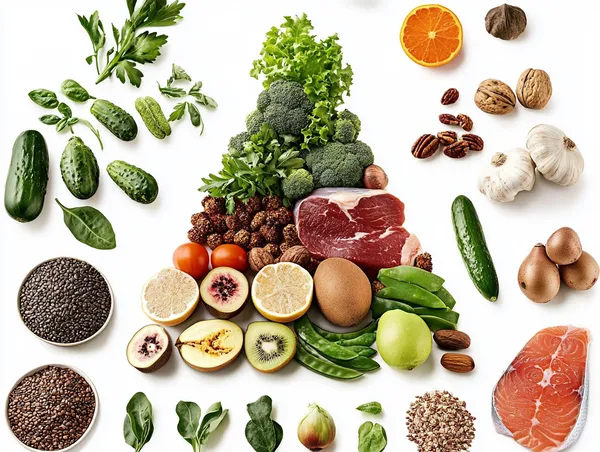On this page
What is Paleo?
People often ask, "What does being Paleo mean?" Simply put, the Paleo diet includes lean meats, fish, vegetables, fruits, nuts, and seeds, while excluding all processed foods, dairy products, grains, and legumes. Essentially, it focuses on the food groups that were available to humans during the Paleolithic period, prior to the rise of farming and modern food processing.
On the surface, it sounds simple, right? But, in reality, there's more to it, especially when you compare it to mainstream nutritional guidelines like the USDA Food Pyramid.

Examining the USDA Food Pyramid
The USDA Food Pyramid has been a staple in nutritional education for years, advocating for a balanced diet that emphasizes grains, fruits, vegetables, proteins, and dairy. Take a look at the traditional USDA Food Pyramid that was introduced in 1992:
In this pyramid, the base recommends 6-11 servings of bread, cereal, rice, and pasta. That's a lot of processed, starchy carbohydrates. Not only that, but most of these foods often contain added sugars, further contributing to an excess of refined carbohydrates in our diets.
Vegetables and fruits are next in line, which is great, but I’d really prefer to see veggies and fruits at the base of the pyramid rather than grains. Protein and dairy, which are vital sources of nutrition, are recommended at only 2-3 servings. And at the top of the pyramid? Fats, oils, and sweets, which are advised to be used sparingly. It’s no wonder that obesity and autoimmune conditions are on the rise.
Take a moment to think about this: 39.8% of Americans are obese and 23.5 million suffer from autoimmune diseases (CDC, NIH). That food pyramid isn’t just misguided—it's failed us.
My Experience with the Standard American Diet (S.A.D.)
I was a junior in high school when I was diagnosed with Multiple Sclerosis (MS). My diet back then was what many refer to as the Standard American Diet (S.A.D.)—high in processed foods, filled with sugary drinks, dairy, and plenty of grains, much like the base of the USDA Food Pyramid.
Now, looking back, I see the problems with this approach. It wasn't balanced; it wasn't nourishing. And it led to years of struggling with my health. I was horrified at the idea of my own children growing up with the same nutritional guidelines. Fortunately, there is an alternative—one that has completely changed my life.

Why Paleo?
After reading Minding My Mitochondria by Dr. Terry Wahls and consulting with a functional medicine doctor, I discovered that I had sensitivities to dairy and gluten, along with an allergy to peanuts. It only made sense to adopt the Paleo lifestyle, eliminating foods that were causing my body harm. Once I did, my relapses stopped—completely.
I used to relapse every 1-3 months for seven years. My relapses were severe: complete paralysis on the right side of my body, numbness, the inability to speak, optic neuritis, and mood swings. I even had a handicap sign for my car by age 23 because I was considered disabled. The turning point came during Christmas of 2007, when I woke up unable to speak and completely paralyzed on one side. That moment was terrifying. It wasn't until I went Paleo that my health began to change—and change dramatically.
Since becoming Paleo, I haven't had a single relapse. By changing what I put in my body—including cutting out MS medications—I got my life back.
Common Allergies & Sensitivities
Many of the foods that Americans are commonly allergic or sensitive to—such as dairy, gluten, and legumes—are all foods that became staples after we transitioned to farming. According to the Food Allergy Research & Education (FARE), dairy, gluten, and peanuts are frequent offenders when it comes to allergies and sensitivities. So why are we continuing to promote these in our national food guidelines?
The Paleo Lifestyle: Beyond Food
Paleo isn’t just about diet; it's a lifestyle. When I adopted Paleo thirteen years ago, everything changed. It wasn’t just about what I ate—it was about what I bought, what I wore, and how I approached my life. I read every label, researched every ingredient, bought local and organic produce. I even started my own organic vegetable garden and made my own beauty products. I became more mindful about everything I put in or on my body.
After seven years of feeling like my body was betraying me, the change was almost immediate. The relapses stopped, and I felt alive again. It’s amazing what changing your diet can do for you.

Taking Control of Your Health
When I look at the USDA Food Pyramid, I see a set of guidelines that do not reflect our true nutritional needs. Instead, I follow a diet that aligns with what our bodies are naturally meant to consume. The Paleo approach may not be for everyone, but it saved my life—and it might change yours too.
Explore More
If you want to learn more about how food can transform your health, keep exploring That Paleo Chick. We offer insights into healing foods, lifestyle tips, and recipes that could make all the difference. Remember to subscribe to get the latest updates and become a member to access exclusive content. Your health journey starts with the choices you make every day—and we're here to help guide you.








